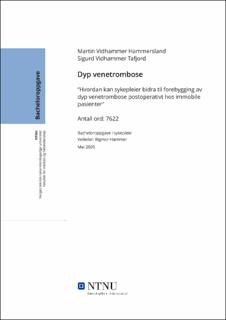| dc.contributor.advisor | Rigmor Hammer | |
| dc.contributor.author | Martin Vidhammer Hammersland | |
| dc.contributor.author | Sigurd Vidhammer Tafjord | |
| dc.date.accessioned | 2020-07-19T16:03:27Z | |
| dc.date.available | 2020-07-19T16:03:27Z | |
| dc.date.issued | 2020 | |
| dc.identifier.uri | https://hdl.handle.net/11250/2669667 | |
| dc.description.abstract | Sammendrag
Bakgrunn: Pasienter som er innlagt på sykehus etter et kirurgisk inngrep har 135 ganger så høy risiko for å utvikle dyp venetrombose. Risikoen øker betraktelig når pasienten blir immobil etter operasjon, som kan føre til utviklingen av komplikasjoner. Som sykepleier jobber man nært pasienten, og har en avgjørende rolle i den postoperative fasen.
Hensikt: Å belyse hvilke kunnskaper og holdninger sykepleier må ha for å kunne være med å forebygge dyp venetrombose hos immobile pasienter i en postoperativ fase.
Metode: Dette er en systematisk litteraturstudie, som baseres på åtte forskningsartikler, med en kombinasjon av kvalitative og kvantitative studier. Studiene er funnet gjennom databasene Cinahl og Medline og valgt ut på bakgrunn av Evans analysemodell.
Resultat: Gjennom analysen kom vi fram til tre hovedkategorier; kunnskap og holdninger, mobilisering og organisatoriske forhold.
Konklusjon: Denne litteraturstudien konkluderer med at sykepleiers kunnskaper og holdninger er avgjørende for kvalitet i pasientforløpet og forebygge dyp venetrombose. Tidlig mobilisering har en positiv effekt på tilhelingsprosessen og bedring i pasientens fysiske funksjon.
Organisering av avdelingen og samhandling mellom profesjonene må forbedres for å opprettholde behandlingskvaliteten. | |
| dc.description.abstract | Abstract
Background: Patients admitted to hospitals after a surgical procedure have 135 times the risk of developing deep vein thrombosis. The risk increases significantly when the patients becomes immobile after surgery, which can lead to the development of complications. Nurses role is crucial in the post-operative phase, working closely with the patient.
Aim: To gain deeper insight into the knowledge and attitudes nurses need to have in order to help prevent deep vein thrombosis in immobile patients in a post-operative phase.
Method: This is a systematic literature study, based on eight research articles, with a combination of qualitative and quantitative studies. The studies were found through Cinahl and Medline and selected on the basis of Evans analysis model.
Results: Through the analysis we came up with three main categories; Knowledge and attitudes, mobilization and organizational compentence.
Conclusion: This literature study concludes that the nurse´s knowledge and attitudes are crucial to quality in the patient course and prevention of deep vein thrombosis. Early mobilization has a positive effect on the healing process and improvement in the patient´s physical function.
Organization of the departement and interaction between the professions must be improved to maintain the quality of treatment. | |
| dc.publisher | NTNU | |
| dc.title | Dyp venetrombose | |
| dc.type | Bachelor thesis | |
